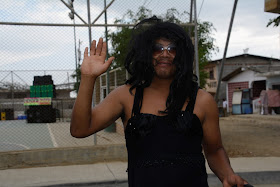Ecuadorian Old Year’s Feast is a very peculiar kind of celebration.
The old year is burned so that the New Year can begin.
His wives are left behind, as widows. Traditionally they carry the baby
of the new year around. Asking for money to raise him.
Today the widows are young men disguised as women. The baby is most
times forgotten. But the old year is burned with religious fervor.
All around the country effigies, dolls made from papier mache or sewn
and filled with sawdust, are sold to people. The most popular ones have the
faces of politicians or figures of popular culture.
This year among the most popular ones were the Ecuador’s current president
and the characters from Star Wars.
Where does this tradition come from? One of the legends come from Napu
runa, or Kichwa people of Ecuador’s Amazon basin.
The group of stars that Napu runa calls Wata Wawa (the Pleiades) helps
them to count the years.
Wata Wawa disappears from the sky in the month of May. Hiding themselves
in the side of the sky where the sun sets, or the west.
Close to the winter solstice (the summer solstice on the northern
hemisphere) the stars appear again. This time like children from the side of
the sky where the sun rises, or the east.
It is the winter and very cold when Wata Wawa appears. This is also the
season when the rains are hardest in the Amazon basin.
At the dawn one can see Wata Wawa together, like a ball of light, over
the jungle. Every day they climb higher, until they reach the top of the sky
and are seen over our heads.
Thanks to this group of stars our ancestors learned to count the years.
Wata Wawa appears every year to announce the arrival of summer later on.
The summer in the Amazon basin is long. It is the time when it doesn’t
rain as hard as during the winter months.
The festivities of old year are the time when people throw away the old
year, Wata Mama, the mother of the year. It is time for her to go and the year
to renew itself.
After winter solstice the New Year appears, again as children, Wata
Wawa, year children. Little by little these children will grow old and become
Wata Mama again.
In the old times during the month of May Napu runa would celebrate the
Wata Mama. People would play shilingatus and rondadoras.
The people would dance the tushuna with small steps. The women would
form a line and grab hold of a man from behind.
The people would sing:
I bring you Wata Mama
Today I take her for a walk,
I take her to dance.
I take Wata Mama for a walk.
Today she is coming,
Through the whole house I’ll walk her.
I just bring her,
I take Wata Mama for a walk,
To your house I’m taking her.
After the dance it was the time to cut the wood. Umisha is a sacred
trunk of wood. While she was cut the runas would play sacred music with their shilingatus.













Hey Joanna, thanks for posting this. It is a very interesting look into other cultures. Being in the US it is easy for me to think we all see the New Year in the same way when that clearly is not the case.
ReplyDeleteThe festivities for New Year's Eve are very different from Finland also. Which is why it's so interesting for me find out the history and traditions behind everything that I see around.
ReplyDeleteAnd I must say the first New Year's Eve I spent here felt like the beginning of a war. Bombs and burning bodies everywhere. Ecuadorian's rather appreciate the firecrackers with loud booming noises. Not so much the colors.